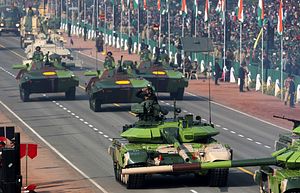The absence of defense reforms means that India’s armed services are not optimally geared to fight the country’s foes. The Indian Army’s capabilities are not atrophying catastrophically, but the snail’s pace at which they are proceeding does constrain the service. These constraints manifest themselves in the resource allocations made to the armed services. The Indian defense budget for 2019-2020 falls short of expectations with allocations for revenue expenditure exceeding capital expenditures. India’s defense budgets over the last few years have witnessed a steady decline. This decline is owed in part to government priorities shifting from defense to nonmilitary expenditures and more generally civilian and military indifference to fundamental reforms in the way Indian armed forces are structured and trained.
As resources shrink, it has become imperative for the Indian Army (IA), which is the largest of the three services, to think more strategically, develop doctrinal clarity about its evolving Electronic Warfare and Cyber Warfare (EW and CW) capabilities, and articulate a more coherent view of how it plans to deal with its operational requirements in the face of the military reforms introduced by China since 2015. India’s land warfare doctrine as well as the triservice doctrine are not well synchronized with India’s existing command and control (C2) architecture.
The military reforms introduced in 2015 by Chinese President Xi Jinping were far-reaching to the extent that they have expanded the Central Military Commission’s direct control over military operations and operational forces and all the technical functions were consolidated under the People’s Liberation Army Strategic Support Force (PLASSF). The PLASSF’s establishment reflects a shift in priorities, with a greater focus on using a wide range of intelligence sources in supporting military operations.
Integrating cyber operations with EW has been a longstanding PLA theoretical requirement and the basis of China’s current information warfare capabilities and operations. The Chinese recognize the complementarities between EW and CW and the role the electromagnetic spectrum plays for both forms of warfare. The establishment of theater commands is tailored to exploit the creation of a unified information warfare service in the form of the PLASSF. For China, there is a link between EW and CW, or what China calls Integrated Network Electronic Warfare (INEW) and its relationship to ground warfare. China is ahead in recognizing both conceptually and technologically the importance of the linkages between EW and CW.
While China does not have a formal doctrine or one that is publicly available, India does. In contrast, within the IA land warfare doctrine there is little discussion of how EW and CW merge and whether a consolidated approach should be undertaken for combined cyber and electronic warfare operations. For China, employing the instruments of INEW will be particularly applicable in the early stages of a conflict with India. This is largely due to the Chinese having a more coherent view of EW and CW than the IA.
For example, modern armies, including the PLA and the IA, depend on unmanned aerial vehicles (UAVs). Cyberattacks could be launched against UAVs’ sensor nodes by manipulating their sensor input and functions. Triggering existing malware could disable UAVs by generating denial of service attacks or mislead the processes on which the UAV network’s sensors are dependent and generate a failure in the fail-safe mechanisms of the UAV network.
The IA and India, on the other hand, have yet to fully acknowledge the convergence between cyber warfare and electronic warfare, whether doctrinally, operationally, or organizationally. The IA thinking about the relationship between CW and EW and how both can play out through the electromagnetic spectrum is, at best, evolving. More thought will have to be given to whether the PLA’s INEW approach is suitable and most effective to meet the needs of the IA’s ground warfare operations.
From an organizational and integrative perspective, as noted earlier, there is support for combining EW and CW under a single commander or formation, but there is little discussion at least at the Indian end about CW and EW under a single combatant command. Based on the foregoing analysis, developing organic CW and EW capabilities is vital for the Indian Army at different echelons from the corps to brigade level. At the tactical level, more personnel from the Corps of Signals may need to be trained in the cyber and electronic domains. Electronic warfare and cyber warfare officers should be embedded in the lower echelons of the chain of command. Finally, India’s C2 architecture must keep pace with shifts in tactical doctrine. Without shifts in doctrine that is compatible with C2 at the Indian end, the IA is likely to face daunting challenges in dealing with its powerful northern neighbor.

































